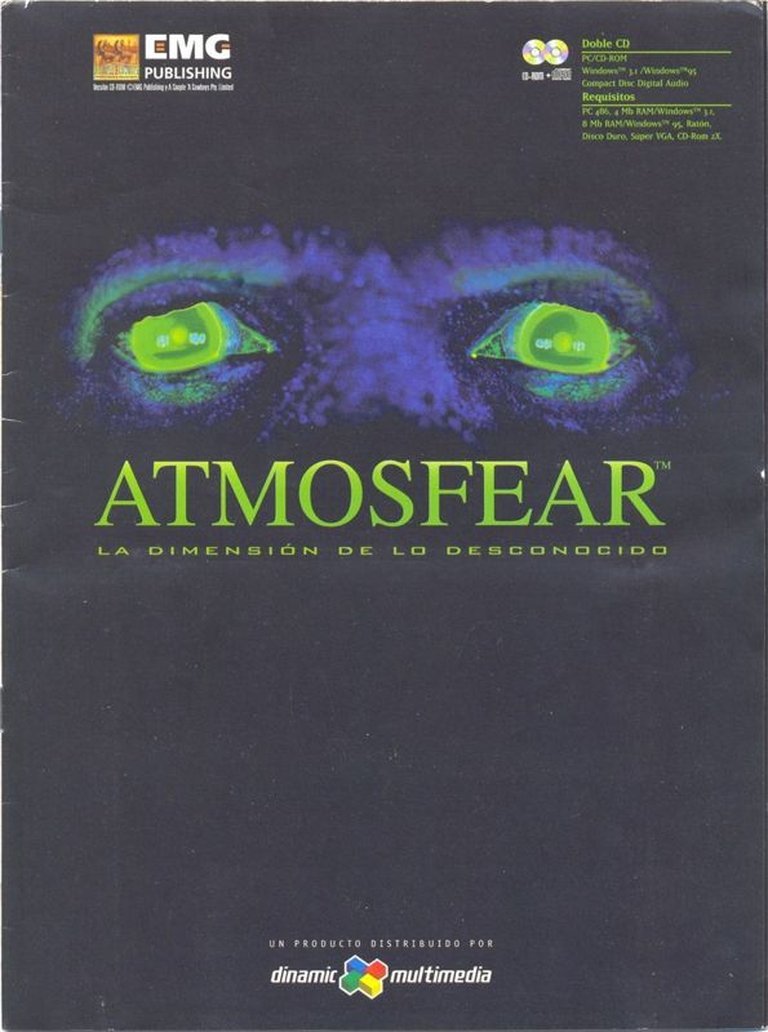- Release Year: 1995
- Platforms: Windows 16-bit, Windows
- Publisher: Dinamic Multimedia, S.A., EMG Publishing
- Developer: A Couple ‘A Cowboys Pty Limited
- Genre: Strategy, Tactics
- Perspective: 1st-person
- Game Mode: Hotseat, Single-player
- Gameplay: Board game
- Setting: Horror
- Average Score: 39/100

Description
Atmosfear: The Third Dimension is a 1995 horror-themed board game adaptation where players race against time to escape the undead realm of the Gatekeeper. Each player selects a character, collects six colored keys from different provinces, and journeys to the center to confront their greatest fear while evading the Gatekeeper’s pursuit.
Gameplay Videos
Atmosfear: The Third Dimension Free Download
Atmosfear: The Third Dimension Guides & Walkthroughs
Atmosfear: The Third Dimension Reviews & Reception
collectionchamber.blogspot.com : Ultimately, they’re rather lacklustre games with the only redeeming feature being the terrifyingly made-up yet hilariously acted videos.
Atmosfear: The Third Dimension: Review
Introduction
In the mid-90s, as CD-ROM technology promised new frontiers in multimedia entertainment, A Couple ‘A Cowboys Pty Limited boldly ventured to adapt their popular horror board game series into a digital realm. The result was Atmosfear: The Third Dimension, a captivating fusion of strategy, horror, and multiplayer chaos that still echoes in the annals of video game history. This review delves into the game’s multifaceted identity, exploring its development, narrative depth, gameplay innovations, and lasting legacy.
Development History & Context
Born from the intersection of board game nostalgia and early PC gaming ambition, Atmosfear: The Third Dimension was conceived by Brett Clements and Phillip Tanner of A Couple ‘A Cowboys Pty Limited. The original board game utilised VHS tapes for atmospheric events, and this digital iteration aimed to leverage CD-ROM’s multimedia capabilities to enhance the immersive horror experience.
Development faced significant technical hurdles. Translating the board game’s tactile elements into a virtual first-person environment required innovative solutions, especially considering the limited processing power of mid-90s PCs. The design team, led by creative director Brett Clements and executive producer Phillip Tanner, worked tirelessly to balance fidelity to the original gameplay with the new medium’s possibilities.
Narrative & Thematic Deep Dive
The narrative of Atmosfear: The Third Dimension is a masterclass in horror storytelling. Players assume the roles of iconic Harbingers—vampires, zombies, witches, and more—each with unique abilities and fears. The goal is to collect six mystical keys scattered across treacherous provinces before facing the malevolent Gatekeeper in a final showdown.
The game’s narrative is steeped in atmospheric dread, with the Gatekeeper’s taunting voiceovers and eerie ambient sounds pervading every moment. The随机出现的事件,如遭遇黑洞或与其它玩家的决斗,增加了紧张感和不可预测性。每个玩家的行动都可能影响整个游戏的走向,这种互动性强化了恐怖体验的实时性。
深层次的主题探讨了对未知的恐惧、时间的紧迫以及人类在面对超自然力量时的渺小。玩家必须在有限的时间内做出策略性决定,这种时间压力加剧了游戏的紧张气氛。
Gameplay Mechanics & Systems
At its core, Atmosfear: The Third Dimension is a turn-based strategy game with a unique blend of luck and skill. Players roll dice to navigate through the provinces, collect power points, and engage in tactical duels. The first-person navigation, while innovative for its time, presents both immersion and disorientation challenges.
Key gameplay systems include:
-
Power Points & Duels: Players accumulate power points which are used in duels to attack or defend. Victorious players can either take an opponent’s key or cast a curse, with each Harbinger possessing distinct curses.
-
Key Abilities: Collecting keys grants special abilities that can alter movement, power point generation, or defense. These dynamic power-ups add strategic depth to each player’s approach.
-
Gatekeeper Encounters: Random encounters with the Gatekeeper can bestow benefits or punishments. These interactions often involve mini-games that test reflexes or luck.
-
Navigation & Orientation: Navigating the 3D provinces requires careful use of the overhead map and visual landmarks. The first-person perspective can be disorienting, making route planning crucial.
尽管玩家可以选择单人游戏,但本作在多人模式下真正发光发热。最多六名玩家围坐电脑旁,共享屏幕,实时讨论策略或施展心理战,这种社交互动是其核心魅力所在。
World-Building, Art & Sound
The world of Atmosfear: The Third Dimension is a masterstroke in horror aesthetics. Each province is a meticulously designed pre-rendered 3D environment, ranging from the decaying elegance of Elizabeth Bathory’s castle to the primal terror of Khufu’s desert tomb. These diverse locales are brought to life through atmospheric sound effects, chilling music (via an included audio CD), and dynamic lighting.
The visual design cleverly combines gothic horror with surrealist flair, creating a nightmarish realm that feels both familiar and alien. The character designs, particularly the Harbingers, are iconic and instantly recognizable, each with distinct personality traits reflected in their abilities and animations.
The sound design is equally impressive. The Gatekeeper’s gravelly voice, teleportation effects, and chilling ambience contribute to an immersive soundscape that keeps players on edge. The inclusion of an audio CD with ambient tracks was a innovative way to enhance immersion beyond the game’s own audio output.
Reception & Legacy
Upon release, Atmosfear: The Third Dimension received mixed reviews. Critics praised its atmosphere, multiplayer interaction, and visual design but criticized gameplay imbalances, particularly the prevalence of penalties over rewards. The PC Zone review noted it as “fun played in a group” despite its flaws.
Over time, the game’s reputation has evolved. Now considered a cult classic, it’s celebrated for pioneering the digital adaptation of board games and pushing the boundaries of CD-ROM multimedia. Its influence can be seen in subsequent horror-themed strategy games and multiplayer experiences that emphasize social interaction and psychological warfare.
Conclusion
Atmosfear: The Third Dimension stands as a testament to the creative spirit of the 90s PC gaming era. While its gameplay may not age perfectly, its atmospheric depth, multiplayer ingenuity, and visual audacity ensure it remains a memorable entry in video game history. Best experienced with a group of friends and the lights dimmed, it offers a unique blend of horror, strategy, and camaraderie that continues to captivate audiences decades after its initial release.